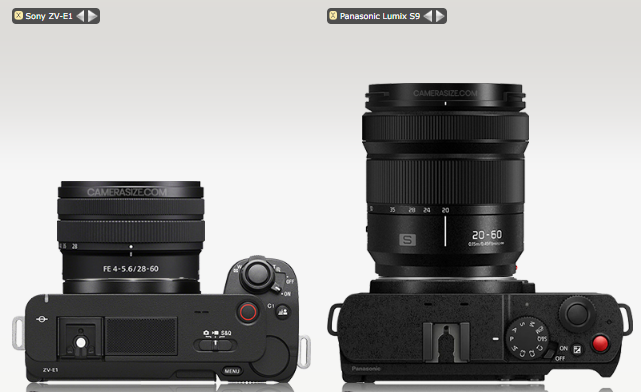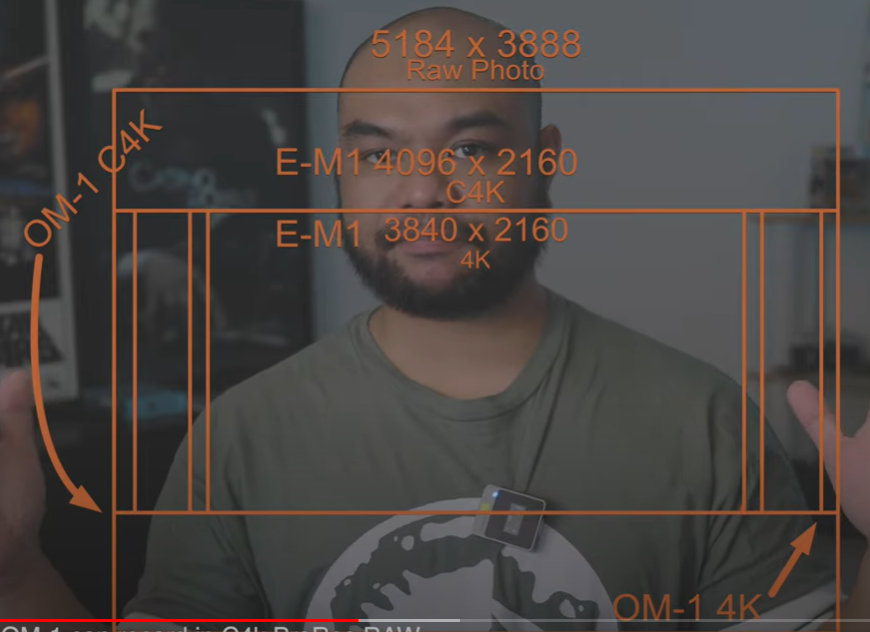
ac6000cw
Members-
Posts
683 -
Joined
-
Last visited
Content Type
Profiles
Forums
Articles
Everything posted by ac6000cw
-
Only in a very niche segment with the GH7 (that other major companies aren't interested in). The S5 ii is aimed at the 'high perceived value' segment by majoring on firmware features while keeping the hardware costs lower by using an older/slower sensor and sharing a body across multiple cameras. It would be interesting to know how profitable (or not) the Panasonic camera division actually is.
-
But the FX30 is almost twice the price, much heavier and larger - they're aimed at different users/market segments. A size comparison of the ZV-E10 ii, A6700 and FX30 which (AFAIK) all use the same APS-C sensor and battery - https://camerasize.com/compact/#927,910,895,ha,t I think as far as Sony is concerned, 'you pay your money and take your choice' (or consider the Fuji X-S20 instead).
-
From the DPReview initial review (my bold):
-
From Canon press release:
-
From DPReview: R1 - https://www.dpreview.com/news/5361436240/canon-announces-eos-r1-flagship-sports-photojournalism-camera R5 ii - https://www.dpreview.com/reviews/canon-eos-r5-ii-initial-review
-
That's basically an amplified version of the sensor background noise (its 'noise floor') - it's not 'mosquito' noise. (And what's 'violent' about lifting the shadows in video? - 'dramatic' or 'drastic' might be a better term to use)
-
The Sony ZV-E1 is smaller and slightly lighter, has the same full-frame, video-orientated, fast readout 12MP sensor as the A7S iii & FX3, I assume records gyro data for post-stabilisation and has a much wider range of lenses available. It's more expensive than the S9 at the moment, but E-mount versus L-mount lens costs might reduce that difference.
-
Isn't the 'mosquito-noise' more likely to be the result of the high levels of compression used for the streaming? (Mosquito noise as defined here - https://en.wikipedia.org/wiki/Compression_artifact#Mosquito_noise )
-
E-M1 iii hdmi RAW output uses a center crop - it's the inner rectangle in the graphic below (from the video at 4:39): AFAIK, Nikon also use sub-sampling for some frame sizes of N-raw video, and ProRes RAW, BRAW and N-raw use lossy compression - so you don't really get raw sensor data, it's always been processed. The main point of (pseudo) raw video is to give you files with higher bit depth and DR (than e.g. 10-bit log) plus probably metadata about the sensor characteristics to allow more latitude to adjust color balance, correction, exposure etc. in post. This is the same guy's general take on using OM-1 for video (which I'd mostly agree with): Not raw video, but this is DPReview's video test chart comparison of DCI 4K on the OM-1 (10-bit) and GH6 - they are very close in sharpness/resolution and having minimal aliasing/moire. That suggests to me that for internal UHD/C4K 10-bit video at 24/25/30p, the OM-1 is using over-sampling, not line-skipping.
-
Yep - it's exactly what you'd expect a major consumer electronics company to do (and Sony has been a pre-eminent one of those for many decades), and is pretty much what they've done in the full-frame MILC area - pushing out five generations of A7 cameras in a decade, including standard, high res (R), compact body (C) and video orientated (S) versions.
-
As BTM_Pix said in the first post, Sony will sell loads of ZV-E10 ii. Sony has deliberately created a video/content creation oriented camera line (ZV-1x, ZV-E10x, ZV-E1, FX30, FX3) to sit alongside their stills orientated line (RX100x, A6x, A7x, A9, A1), with a clear upgrade/upselling path from low end to high end in each case. I don't think any other camera company has that, so it makes Sony the obvious video/content creation go-to brand for people who want to move away from using a smartphone or action cam for it. Sony obviously set out to dominate that area of the market a few years ago and I think they're succeeding - their competitors are either playing catch-up or just not bothering/can't afford it and heading down their own niche rabbit hole. Not all of the ZV-line are brilliant cameras, but they don't have to be when there's a better/different/more expensive camera you can sell customers instead.
-
DPReview have changed/corrected their comment about crop levels in different modes:
-
From DPReview's 'Initial Review' - https://www.dpreview.com/reviews/sony-zv-e10-ii-initial-review So in 4K with digital stabilization, that's total crop of 1.45x (out of an APS-C sensor, so it's close to being a 12MP M43 sensor equivalent when digital IS is enabled). But it's cheap for a 10-bit 4K60p large-sensor camera and the 4K rolling shutter should be decent. (Why do Sony - and some others - persist in fitting low-res 1.04 million dot screens to their cameras? At least the S9 has a decent 1.84 million dot screen)
-
I like and use their cameras, but I think unless OMDS gets its R&D really motoring I suspect it won't be around long-term in it's current form - re-cycling older camera tech and doing mostly cosmetic makeovers of existing lenses isn't really a sustainable strategy if you're competing with giant corporations like Sony and Canon. It's been 3 1/2 years since JIP took 95% ownership of OMDS and we've had one new camera with 'new tech' inside it - the OM-1 (which was mostly developed before the takeover), a 'mark 2' warm-over of that, and one re-packaging of the E-M1 iii tech into a smaller body - the OM-5. This seems slow progress for a company with 1850 employees and a 'Share Capital and Capital Surplus' of 41.7 billion yen (USD 258 million) in March 2023. As for Panasonic M43 - it might surprise us, but I'm not hoping for much more than maybe a GX9 equivalent based on the S9 body with an EVF added. The G9ii/GH7 sensor would be great, but it might push the price too high - on the other hand that would be re-using the sensor and tech from those cameras so maybe not...
-
Yes, good point, I'd forgotten about the F3 - https://zoomcorp.com/en/gb/handheld-video-recorders/field-recorders/f3/ Less than half the size of the H4e but about the same weight (but you get 4-channel recording capability with the H4e). Now there are some decent mics around with built-in A-D converters and a USB-C connection (and all the recorders that can operate as a USB mic), I think it's time that video-orientated mirrorless cameras dropped the 3.5mm jack input and supported USB digital audio input devices instead...
-
The second link is to an in-line attenuator, the opposite of a pre-amp... Another option is to use a decent hand-held recorder with XLR inputs as the mic amp then feed the output of that into the camera. if you use one of the latest Zoom models (e.g. the H4essential) you can have a 32-bit float backup recording as well.
-
Oly/OMDS cameras I've used have an 'MF' function you can assign to a button - it stops C-AF and enables the lens focus ring. After you've done the manual focus, press it again and AF takes over again. When going from MF to AF it doesn't force the AF to re-focus so basically (if C-AF is enabled and the in-focus part of the image is within the AF area) the C-AF will hold your focus. Also in MF mode you can push the AF-ON button to force an S-AF re-focus. On my OM-1 I normally have video AF set to C-AF, then using the MF and AF-ON buttons I can switch between C-AF, MF and MF+S-AF while recording if I want to. (Oly/OMDS cameras don't have an AF-lock function, so the MF function is the next best thing - you just have to be careful not to touch the focus ring accidentally...)
-
The 'n-stops of IBIS' ratings are based on shooting stills. They are a comparison of 'how low a shutter speed can we hand-hold and get a sharp image' so it's about the image being as 'locked down' as possible. The behavior of IBIS in video mode is normally different, where usually it looks much better if it's 'floaty' to a reasonable extent. Also everyone holds and moves the camera differently, so video IBIS behavior that works great for one person might not work as well for another. You really have to try the camera and decide if you like the video IBIS behavior.
-
Yes, it's a version of the 'no one gets fired for buying IBM' situation - it's all about minimizing the (large) financial risks in high-end production. A very different situation from a one/few person production company doing filming and post-production in-house with their own relatively low-cost workflow (e.g. using Blackmagic cameras and software).
-
Sounds sensible to me - small, light, unobtrusive and take 'good enough' video and stills. The same basic reasons I'm about to go out for the day with a pocket-sized ZV-1 instead of my OM-1 (despite the terrible battery life and the annoying user interface).
-
Which MediaInfo visualisation is the best one to see all the extra info?
-
A few Oly/OMDS lenses have OIS and support Sync-IS (their version of Dual-IS) i.e. the 12-100mm F4 and some of the long and expensive telephoto lenses.
-
Lens was Oly 12-200mm, used at the wide end (maybe between 12 and 15mm). No lens OIS. With IBIS at +1 level you get some jitter with fast camera movement, so level 0 would be better for that. Enabling EIS in the camera should handle walking much better. If I was going to use the 'walking' parts of that video I'd probably also add stabilisation in post. (I don't normally do 'walking with the camera' stuff, but I happened to have that recording).
-
For an example of walking with the OM-1 using just sensor-shift IBIS, see my post here - https://www.eoshd.com/comments/topic/87236-how-do-om1-mkii-or-even-om1-dci-4k-video-quality-comparing-to-gh7-or-even-gh6/?do=findComment&comment=713229
-
Just added a clip of walking along using only sensor-shift IBIS (probably on the max +1 video stabilisation setting) in the 'IBIS_walk' folder (OM1_walking_with_IBIS_P8260305.MOV) It's quite wide-angle so has a fair amount of corner warping, but I really like the way it becomes very stable as soon as you stop walking.






